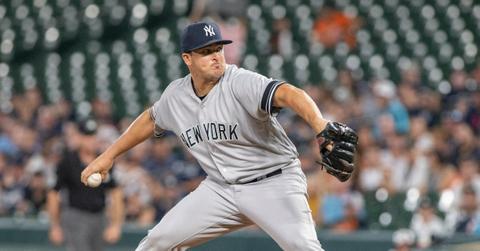Why Do Pitchers Lick Their Fingers? There's a Good Reason For It
"The pitcher shall not touch the ball after touching his mouth or lips, or touch his mouth or lips while he is in contact with the pitcher’s plate."
Updated Oct. 29 2024, 5:14 p.m. ET
Baseball has been one of America's favorite sports for generations, and as it has become intertwined with America's identity, people feel strongly about their baseball traditions ... including some that may seem bizarre to outsiders.
One such tradition could be noted on the pitcher's mound prior to 2020: a pitcher licking their fingers before grasping the ball. This age-old tradition has been fiercely defended by those who do it but faced pushback during the COVID pandemic. Here's why pitchers lick their fingers.
Here's why pitchers lick their fingers, at least according to those who do it.
Pitchers who lick their fingers say they do it to improve their grip and increase their grip friction as they release the ball. Unfortunately for proponents of the habit, it was banned in June of 2020 at the height of the COVID pandemic. Concerns about the transmissible nature of the virus and spit spurred the change.
The MLB rulebook Pitching Prohibition section reads, "The pitcher shall not: While in the 18-foot circle surrounding the pitcher’s plate, touch the ball after touching his mouth or lips, or touch his mouth or lips while he is in contact with the pitcher’s plate." It adds, "The pitcher must clearly wipe the fingers of his pitching hand dry before touching the ball or the pitcher’s plate." Pitchers are, however, allowed to use a damp rag carried in their back pocket to wet their fingers.
It may seem like a surprisingly simple rule to enact, but there was pushback when it first went into effect. Those who lick their fingers say that the consistency difference between saliva and water on a rag means that it's not as effective to moisten their fingers with a rag. Nonetheless, MLB officials are serious about this rule and pitchers have even been penalized for accidentally doing it.
There's actually a lot of spitting in baseball, if you haven't noticed.
Of course, those who watch baseball might note that the pitcher's mound isn't the only place where saliva makes an appearance during the game. Players spit all the time.
It comes down to a cultural habit. Chewing tobacco was widely used during MLB's infancy, and it became a cultural posture that players have emulated through the years. Dirt fields used to be more prevalent, and some speculate that it was a result of dust and dirt blowing into early players' mouths. Children who grew up watching this spitting often imitated it and grew up to be men who spit as well.
Now that chewing tobacco is known as a carcinogen, people often turn to chewing gum or sunflower seeds. However, chewing isn't the end of the practice: It also involves a generous spit at the end.
During the COVID pandemic, just like the ban on spit-shining the ball, officials encouraged players to stop spitting as often. And many seemed to reign in the practice out of a concern for their own health and that of their fellow players'. Yet like many other baseball traditions, it seems unlikely that spitting will ever go away entirely. There were concerns about player performance during the most restrictive spit bans, and many officials have eased up on enforcing the on-field spitting as long as they aren't transmitting their spit to the ball itself.

